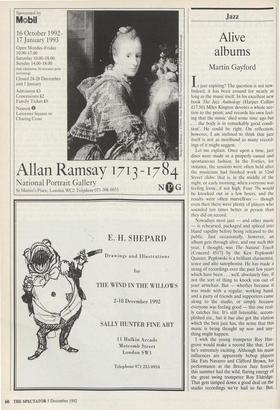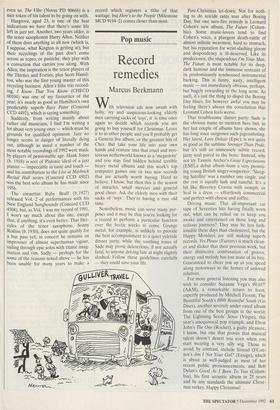Jazz
Alive
albums
Martin Gayford
Is jazz expiring? The question is not new. Indeed, it has been around for nearly as long as the music itself. In his excellent new book The Jazz Anthology (Harper Collins /17.50) Miles ICington devotes a whole sec- tion to the point; and records his own feel- ing that the music 'died some time ago but ... the body is in remarkably good condi- tion'. He could be right. On reflection, however, I am inclined to think that jazz itself is not as moribund as many record- ings of it might suggest.
Let me explain. Once upon a time, jazz discs were made in a properly casual and spontaneous fashion. In the Forties, for instance, the sessions were often held after the musicians had finished work in 52nd Street clubs: that is, in the middle of the night, or early morning, when everyone was feeling loose, if not high. Four 78s would be knocked out in a few hours, and the results were often marvellous — though even then there were plenty of players who sounded ten times better in person than they did on record.
Nowadays most jazz — and other music — is rehearsed, packaged and spliced into bland vapidity before being released to the public. Just occasionally, however, an album gets through alive, and one such this year, I thought, was The Natural Touch (Concord 4517) by the Ken Peplowski Quintet. Peplowski is a brilliant clarinettist, tenor and alto saxophonist. He has made a string of recordings over the past few years which have been . . . well, absolutely fine, if not the sort of thing to knock you out of your armchair. But — whether because it was made with a regular, working band, and a party of friends and supporters came along to the studio, or simply because everyone was feeling good — this one real- ly catches fire. It's still listenable, accom- plished etc., but it has also got the elation which the best jazz has, the sense that this music is being thought up now and any- thing might happen.
I wish the young trumpeter Roy Har- grove would make a record like that. Live he's extremely exciting. Although his main influences are apparently bebop players like Fats Navarro and Clifford Brown, his performance at the Brecon Jazz festival this summer had the wild, flaring energy of the great swing trumpeter Roy Eldridge. That gets tamped down a good deal on the studio recordings we've had so far. But,
even so, The Vibe (Novus PD 90668) is a nice token of his talent to be going on with.
Hargrove, aged 23, is one of the best indications we have that there's some life left in jazz yet. Another, two years older, is the tenor saxophonist Harry Allen. Neither of them does anything at all new (which is, I suppose, what Kington is getting at), but their recyclings of the past don't come across as repro, or pastiche: they play with a conviction that carries you along. With Allen, the inspiration is the tenor players of the Thirties and Forties, plus Scott Hamil- ton, who was the first young master of this recycling business. Allen's lithe trio record- ing, I Know That You Know (CHECD 00104) was one of my favourites of the year; it's nearly as good as Hamilton's own predictably superb Race Point (Concord CCD 4492), which is saying something. Suddenly, from writing mainly about rather old musicians, I find I'm writing a lot about very young ones — which must be grounds for qualified optimism. Jazz no longer seems in danger of literally dying out, although as usual a number of the most notable recordings of 1992 were made by players of pensionable age. Hank Jones (b. 1918) is sort of Platonic ideal of a jazz pianist — impeccable in taste and touch — and his contribution to the Live at Maybrick Recital Hall series (Concord CCD 4502) was the best solo album he has made since 1956.
The cornettist Ruby Braff (b. 1927) released Vol. 2 of performances with his New England Songhounds (Concord CCD 4504), but, as Vol. 1 was my record of 1991, I won't say much about this one, except that, if anything, it's even better. That Her- cules of the tenor saxophone, Sonny Rollins (b. 1930), does not quite qualify for a bus pass yet; in concert he remains an improviser of almost superhuman vigour, sailing through epic solos with titanic imag- ination and vim. Sadly — perhaps for the some of the reasons noted above — he has been unable for many years to make a
record which registers a tithe of that wattage, but Here's to the People (Milestone MCD 9194-2) comes closer than most.











































































 Previous page
Previous page